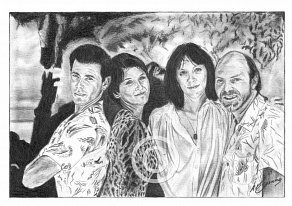The Manhattan Transfer
Pencil Portrait by Antonio Bosano.

Shopping Basket
The quality of the prints are at a much higher level compared to the image shown on the left.
Order
A3 Pencil Print-Price £45.00-Purchase
A4 Pencil Print-Price £30.00-Purchase
*Limited edition run of 250 prints only*
All Pencil Prints are printed on the finest Bockingford Somerset Velvet 255 gsm paper.
P&P is not included in the above prices.



Comments
Riding a wave of nostalgia in the ’70s, the Manhattan Transfer resurrected jazz trends from boogie-woogie to bop to vocalese in a slick, pseudo commercial setting that balanced the group’s close harmonies with innovative instrumental backdrops.
This portrait of the original lineup – which recorded and performed live between 1972 and 1978 – is somewhat disrespectful to Cheryl Bentyne, who would replace Laurel Masse and continues as an active member to this day. A superior vocalist, she just didn’t get in on the story at the beginning and it’s invariably the embryonic beginnings that are the most interesting.
When the group was formed in 1969, the Manhattan Transfer was a hippie novelty act similar to the Lovin’ Spoonful or Spanky & Our Gang. Their lone LP, “Jukin’” – on Capitol Records – featured the original lineup of Gene Pistilli plus Tim Hauser, Erin Dickins, Marty Nelson, and Pat Rosalia. Essentially a satirical record, it was the last appearance on a Manhattan Transfer album for all of the above except Hauser.
Working part time as a New York cabbie, Hauser would provide transportation for vocalist Laurel Masse, a chance encounter that would lead to introductions to her then boyfriend Alan Paul and Janis Seigel. The group’s eponymously titled debut LP featured vocalese covers of “Java Jive” and “Tuxedo Junction” as well as a Top 40 hit in the aggressive gospel tune “Operator,” a staple of their live act to this day. The album rejuvenated the field of vocalese (dormant since the mid-‘60s) and made the quartet stars in the jazz community across Europe as well as America.
‘
The Manhattan Transfer’s next two albums, ‘Coming Out’ and ‘Pastiche,’ minimized the jazz content in favor of covers from around the music community, from Nashville to Los Angeles to Motown. A single from Coming Out, the ballad “Chanson d’Amour,” hit number one in Britain. Though Masse left in 1979 for a solo career, Cheryl Bentyne proved a more than capable replacement, and that same year, “Extensions” introduced their best-known song, “Birdland,” the ode to bop written by Weather Report several years earlier. I saw them on the 1979 UK tour and their vocal abilities in a concert setting were impeccable.
Throughout the ’80s, the group balanced retreads from all aspects of American song. The 1981 LP ‘Mecca for Moderns’ gained the Manhattan Transfer their first American Top Ten hit, with a cover of the Ad Libs’ 1965 girl group classic “The Boy from New York City,” and 1983’s “Bop Doo-Wopp” would remind everyone of their live pedigree. Thereafter, whilst much of the group’s subsequent releases would emphasise their peerless harmony work, the sheer variety of material would prove somewhat difficult to digest. Nevertheless, 1997’s ‘Swing‘ and 2000’s ‘The Spirit of St. Louis’ – a tribute to Louis Armstrong – would be a timely reminder of what I originally loved about them.
During the early 2010s, the group focused more on performing, although both Bentyne and Hauser were forced to find temporary replacements during medical procedures. After spinal surgery in 2013, Hauser returned to the group, but then died suddenly from cardiac arrest in October 2014, bringing to an end the glue that bound the group together. That’s just a personal opinion of course, and following his death, vocalist Trist Curless of the a cappella group M-Pact would join the line-up full-time. In 2018, the Manhattan Transfer returned with the eclectic studio album ‘Junction,’ which they dedicated to Hauser, a fitting tribute to their founder.